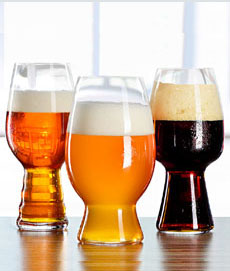TIP: The Right Beer Glass Makes A Big Difference
|
We’re one of the many people who likes to drink beer straight from the bottle. We believed, as with sparkling wine, that the narrower the opening, the more the carbonation stays in. A cold bottle from the fridge keeps the beer colder than a room-temperature glass. And, we don’t particularly care for a foamy head.
But according to Spiegelau, a manufacturer of fine glassware in Bavaria, Germany, we have it all wrong. You only get about 15% of the flavor of the beer when you drink it from the bottle. That’s because smell, not palate, is the major component of taste (and explains why you can lose your taste when you have a badly congested nose and can’t smell). You get zero aroma through the narrow neck of the beer bottle, covered by your mouth as you take each sip. When you pour beer into a glass, the head* releases the bubbles (carbon dioxide) that burst into aroma. On top of that, different types of beer benefit from different shaped glasses, engineered to bring out the special attributes of the beer (Riedel, the parent company of Spieglau, was the pioneer in developing different wine glass types). |

Engineered to bring out the best in American craft beers: from left, IPA, wheat beer and stout glasses. Photo courtesy Spiegelau USA. |
|
|
Different regions have long made different glass shapes for their beers. Think beyond the German stein to the British pint glass; the tall, tapered Pilsner† glass; the stemmed snifter for Belgian ales and IPAs; the tankard for ales, lagers, stouts and porters; and others. See the different types of beer glasses in the chart below. Spiegelau has developed a Craft Beer Glass Collection, with custom-designed glasses for the three most popular American craft beer styles: IPA, Stout and Wheat Beer. Each glass is designed, according to the company, to highlight “the complexity of aromas on the nose while demonstrating the optimum beer texture, balance and flavor intensity on the palate.” Riedel has done this for wine glasses with great success (you won’t believe how much better the wine tastes in a specially engineered wine glass than on a generic one). Now, they’ve done the same for beer. An expert panel of master brewers tested multiple glass shapes before finding the optimum shape for each beer type. Here’s what resulted: Custom-shape beer glasses isn’t hype: It’s precision engineering and it works. Buy yourself a set and test it against what you’re currently using. We had great results with the Spiegelau glasses. Beer glasses are a great gift for beer connoisseurs, and other companies have gotten the custom-shape message. |
||
 Wrong! These are traditional Pilsner glasses, specifically designed to bring out the best qualities in a Pilsener beer. That means that they won’t enhance the flavors of stout (left) and amber ale (center). But wait: The Lenox Pilsner glasses are totally different—a stemmed tulip glass! Photo courtesy WiseGeek.com. |
MORE BEER STYLE-SPECIFIC GLASSES Lenox has a new line of beer glasses in four styles: IPA, Pint With Crown, Stemmed Pilsner and Wheat Beer. And surprise: The shapes are totally different from conventional designs—as well as from the Spiegelau designs. The Pilsner is a stemmed tulip, like the traditional Belgian Ale glass. The IPA and Wheat Beer glasses are tall and narrow with a tapered waist, like the conventional Pilsner glass. The Pint With Crown is a sleeker version of the pub pint glass. Here’s what they say about their shapes: |
|
|
We haven’t tried Lenox or other contenders, and you can’t be sure without trying. So we’ll keep testing, and will keep you posted. See the original chart at DailyInfographics.eu.
|
||



